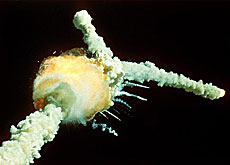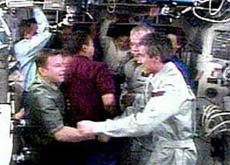Lessons of Challenger “went unheeded”

Twenty years after the Challenger shuttle disaster, Switzerland's only astronaut tells swissinfo that crucial lessons from the tragedy were left unheeded.
Claude Nicollier, who has logged more than 1,000 hours in space, also said one of the shuttle’s key design faults was the lack of an emergency escape system.
Challenger exploded 73 seconds after take-off on January 28, 1986, killing all seven crew members.
Seventeen years later the space shuttle Columbia burnt up on re-entry after one of its wings was damaged by a chunk of foam debris.
A ceremony to remember the Challenger accident took place at Nasa’s Kennedy Space Center in Florida on Saturday.
swissinfo: You were already training with Nasa at the time of the Challenger disaster. What are your memories of the crash?
Claude Nicollier: I remember we were about one year away from my first mission, which of course was cancelled after the Challenger disaster.
I was in Switzerland on the day it happened and… of course it was a huge shock and I returned immediately to Houston.
All our thoughts were about the loss of human life. But after a while you start to think about what the consequences will be for human space exploration. We soon realised that the shuttle programme would continue, but we knew there would be a huge setback in terms of time.
swissinfo: Did the accident make you think twice about signing up for a shuttle mission?
C.N.: When I started this job I knew that space exploration was dangerous. Challenger wasn’t the first space accident, but it was the first of that magnitude. Up until then, the only US accident – the 1967 Apollo 1 fire – happened on the ground.
I became an astronaut because I was convinced that it was a risk worth taking. But the shock was huge: the Challenger crew were seven friends, and I knew some of those who lost their lives on that morning of January 28 very well.
For me there was little doubt that if the shuttle programme was going to survive… [Nasa] was going to have to do a lot of homework to fix the problem, which they did.
swissinfo: So you wouldn’t agree with fellow astronaut Mike Mullane, who recently said that the “true tragedy of Challenger is that nothing was learnt”?
C.N.: Actually, I agree to a certain extent. While the technical causes of both the Challenger and Columbia accidents were different, in both cases management had not paid attention to what the faults were.
In the case of Challenger there were prior warnings of a design problem… and in the case of Columbia there were indications that the external fuel tank was shedding debris during ascent [well before the ill-fated mission].
So Mike Mullane is right in the sense that so many years later, the lessons from Challenger were not heeded. What I mean by that is that attention should always be paid to a problem as soon as it is spotted – because even if it doesn’t immediately cause an accident, one day it will. This is what happened with both Challenger and Columbia.
swissinfo: Mike Mullane has also criticised the fact that the shuttle was built without an emergency escape system. Would you agree that that was a mistake?
C.N.: It certainly was a design error. It is one of the flaws of the shuttle that we have no crew escape system, except for parachutes which can only be used in a small number of situations.
When the shuttle was being designed in the 1970s there were a lot of cutbacks because the project was costing much more than anticipated. So changes were made, including the idea of not having any escape system for the crew. Such a system was considered to be technically too complex, it would have cost too much and meant more years of development.
swissinfo: Looking back at the shuttle’s troubled history – two disasters, the remaining fleet currently grounded – what do you think its legacy will be?
C.N.: The shuttle’s ability to carry out interventions in space, to bring back satellites, to take astronauts to fix something as complicated as the Hubble telescope, is absolutely remarkable. This achievement is going to be unmatched in all the vehicles that are in the planning stage now and for the next few decades.
The shuttle design is such that it is very fragile… so it can get into trouble and have accidents. Hopefully future generations will remember it as a vehicle with extraordinary capabilities, even though the programme was more expensive and [as a result] not as safe as had been anticipated.
swissinfo: Would you go so far as to say that the loss of Challenger and Columbia was a price worth paying for the benefits the shuttle has brought to space research?
C.N.: That’s a really tough question. We are talking about the loss of 14 human lives, which is quite a number when you consider that the astronaut corps is made up of only 140 people.
I’d be tempted to say yes, while at the same time paying the highest respect to my friends who lost their lives. But ultimately how can you measure human life versus a technical or scientific achievement? The shuttle was a courageous idea… unfortunately it was not as safe as I wish it had been.
swissinfo-interview: Ramsey Zarifeh
The Challenger space shuttle exploded 73 seconds after take-off on January 28, 1986.
The cause of the accident was a poorly-designed seal in the shuttle’s solid rocket booster.
In 2003 Columbia broke up as it re-entered the earth’s atmosphere. The cause of the accident was later discovered to be a chunk of foam debris which had punched a hole in the shuttle’s wing.
The remaining shuttle fleet is due to be retired by 2010.
Claude Nicollier was born on September 2, 1944, in Vevey, Switzerland.
He received a bachelor of science in physics from Lausanne University in 1970 and a master of science degree in astrophysics from Geneva University in 1975.
A veteran of four shuttle missions, Nicollier has logged more than 1,000 hours in space.
His first mission was in 1992. His last journey into space was on the shuttle Discovery in December 1999.

In compliance with the JTI standards
More: SWI swissinfo.ch certified by the Journalism Trust Initiative


You can find an overview of ongoing debates with our journalists here. Please join us!
If you want to start a conversation about a topic raised in this article or want to report factual errors, email us at english@swissinfo.ch.